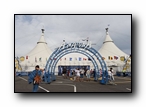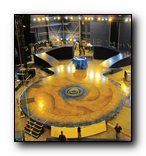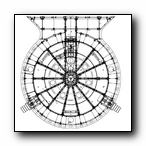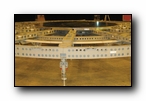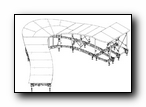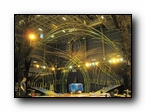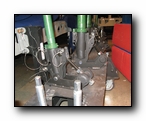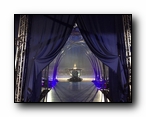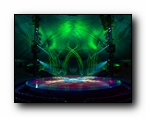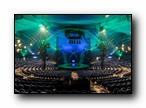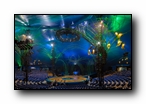|
Performance Space
Amaluna, written and directed by Diane Paulus, invites the audience to a
mysterious island governed and guided by the cycles of the moon. A queen called
Prospera magically interprets the central character and plot from The Tempest,
with an all-female ensemble as her backup band. With itsmostly female cast, the
show honors femininity, renewal, rebirth, and balance, which marks the passing
of these insights and values from one generation to the next.
[ Set & Stage •
Lighting Design ]
"Because of the 70% female cast, we wanted the environment to have a
sensuality to it." - Scott Pask, Set Designer
New York-based set designer Scott Pask, who frequently collaborates with Paulus,
has imagined a forest of bamboo-like branches to embrace the audience as they
visit the magical island to witness a young woman’s coming of age (Miranda,
daughter of Prospera). By using natural elements based on indigenous cultures
from around the world, Pask wanted to provide a supportive structure and home
for the show.
- THE BRANCHES — The branches and limbs of the canopy are unmistakably
engineered constructions; the visual references to bamboo are quite evident. It was
important to Pask that the forest should be seen to be hand-crafted, however there was
no attempt to disguise its components as anything actually found in nature – these
branches are crafted in aluminum with paint treatments, glazing, and gilding to add
texture and the echo of bamboo, but nothing has been given a patina to look like wood,
for example. Yet the feeling of being in a real forest is palpable. The “trees” thrust
upward from the circumference of the stage and the Big Top’s tent poles to form an
airy canopy. Upstage, the vegetation grows closer to the ground, forming a tunnel-like
grotto. (There are 174 branches in 534 sections – 90 in the canopy and 84 upstage –
making a total of 1.7 km or 1.05 miles.) Although meant to invoke the outline of a
peacock feather, the set also evokes the various curves, lines, swoops, and folds of
the female sex, which, coupled with the two side wings of the set (that bare a close
resemblance to fallopian tubes), helps bring the audience into this female-dominated
world.
- PEACOCK FEATHERS — The peacock feather decoration that occupies
much of the middle of the Amaluna stage is a significant emblematic motif that is
echoed in some of Mérédith Caron’s iridescent costumes. The peacock images in the
show are inspired by the magnificent bird that accompanies Hera, the Greek goddess
of women, marriage and fertility. Legend tells us that the protective "eyes" in its
tail watch over women in all the stages of their lives.
- WATER BOWL — Amongst these trappings sits the water-bowl, a soothing
pale-blue.The Water-bowl is a piece of acrobatic equipment that also doubles as a
dramatic set element - A giant, clear gemstone set in a ring of stylized organic
shapes that resemble a vortex captured in time. As it interacts with the lighting,
this "jewel" changes its appearance and aura, much like a real precious stone. It
is 5-feet 5-inches tall, 7-feet, 3-inches in diameter, and weighs 5,500 pounds when
filled with water.
- TURNTABLE — the stage, with its turntable, allows a dynamic relation
with the audience. Scène Éthique designed an axial layout for the turntable base
structure. Their OST system was used in the curved elements as well as on the straight
ones for the turntable and the entire set. The turntable and forestage part of the
stage include traps operated from either the stage surface or the understage. The
waterbowl, manually displaced by the artists, can roll all the way to the center of
the turntable to present different acrobatic numbers. The rolling tracks were
designed to carry the large load imposed by the waterbowl, its water content and the
large base on which aesthetics, light and sound were added. Access to the stage is
achieved by using retractable stairs downstage designed by Scène Éthique.
Pask, who initially trained as an architect, regards the entire space as more of
an art installation than a stage set, and he has used light to activate it and take
the audience to other places and evoke different emotional responses. There are
relatively few moving parts in the set design, and that was a deliberate choice
intended to add certain elegance to the performances by concentrating the audience’s
attention on the human performance. There are no visual effects in the Amaluna set,
and the automated mechanical elements are designed to be inconspicuous – almost
invisible – even though they are in plain view. Circular sections of the stage
revolve to ensure that the entire audience can see each act from every angle, and
that movement is matched by a circular scenic element above the stage: the
Carousel – a custom-made ring that houses downward-facing lighting clusters as
well as anchor points for flying acrobatic performers.
| |
The Grid weighs 8,600 pounds and includes three acrobatic winches, each able to
lift loads up to 400 pounds at 10-feet per second. The acrobatic winch at the center
of the Carousel can lift up to 1,000 pounds at 10-feet per second.
|
At times stationary, at times moving, the 25-foot diameter Carousel can revolve in
sync with the stage, or counter-rotate in the opposite direction to give both the
artists and the lighting maximum flexibility and range of vertical and horizontal
motion. All while packing an impressive 6,000 pound weight. The steel and aluminum
Canopy that supports the ambiance of the show was a challenge by itself since it had
to withstand its own weight without changing the intended look, answer to structural
norms and needed to be set up in a standard Cirque du Soleil schedule. Transportation
constraints were taken into account also. Each bough is comprised of 3 to 6 sections,
bent to different radiuses and joined together by custom-made fast locking engineered
unions designed by Scène Éthique.
Lighting designer Matthieu Larivée of Luz Studio in Montreal added layers of
visual texture to augment the set, and visually tell the story, strictly with
lighting, as there are no projections in Amaluna. One of his challenges is the
weight restriction on the tent masts. “Everything has to hang from these masts,
so the size of the rig is limited,” he notes, adding that he only has two Robert
Juliat Manon followspots, which makes things interesting if there are three
performers flying around. Additional fixtures can hang on some additional trusses,
but again the weight is limited.
Programmed on an MA Lighting grandMA2 console, the lighting combines automated
and conventional fixtures, with gobos in the Philips Vari-Lite VL3000 and VL3500
Spots providing texture on the set, as well as on the dark, interior surface of
the tent, which Larivée used as a large circular cyc to add to the immersive feel
of the environment. All of the lighting gear was purchased for the tour, and
Larivée was able to select the individual gobos, which also add texture to the
floor.
In terms of color, Larivée uses a lot more here than he is usually wont to do.
“I am more of a monochrome designer,” he admits, but to help create the immersive
environment for Amaluna, his colors are more saturated and more intense, adding
another layer of interest to the natural settings that embrace both performers and
audience on a magical island where female ingenuity, nature, and love prevail.
|

![]()


